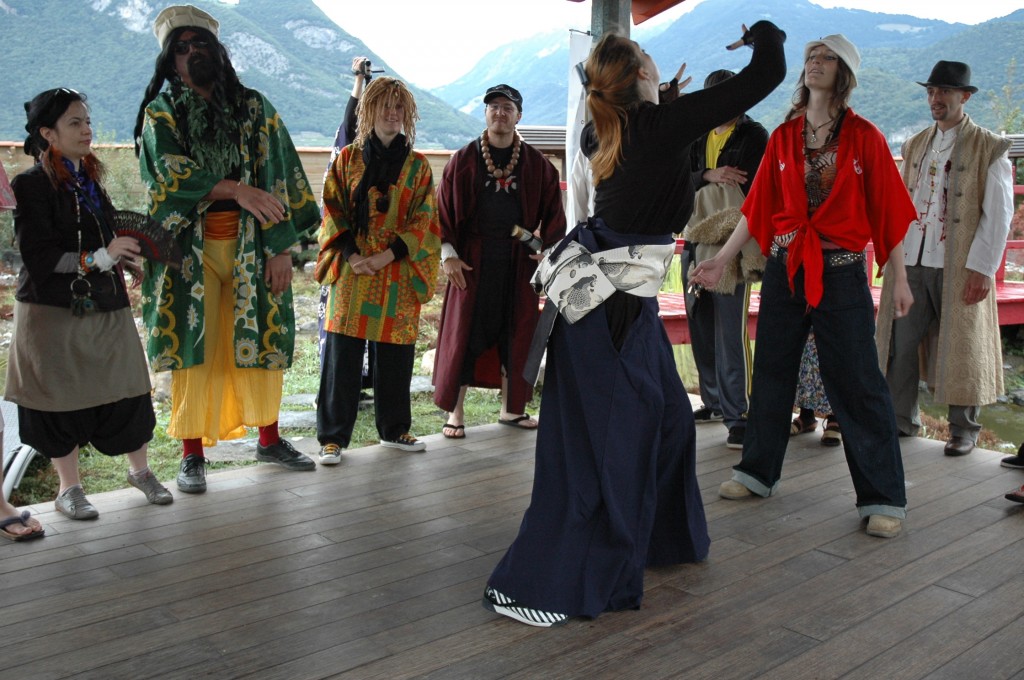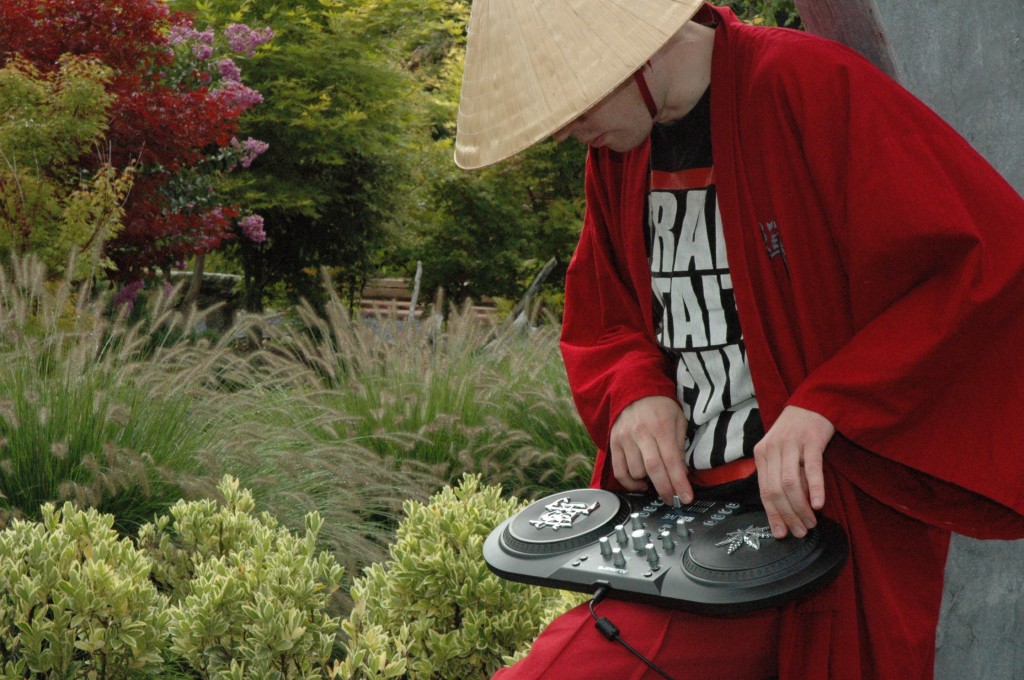Afroasiatik – A kung-fu hip-hop, chambarap and samurasta larp

Is hip-hop still about peace, unity, love & havin’ fun? And can larpers actually rap? (Photo © Valérie Bauwens)
Afroasiatik was a French-Swiss larp run in the zen garden of Aigle, Switzerland, in August 2013. Its goal was to expose larpers to hip-hop themes and enable them to give their first hip-hop performances.
Video documentation
French hip-hop vs. French larp
According to Afrika Bambaataa, the Godfather of Hip-Hop, French hip-hop culture is “definitely the strongest one outside of the United States”. French larp and French hip-hop started in the early 1980s, in very different scenes. As an active fan of both French hip-hop and roleplaying since 1989, I wanted to combine them and create a French hip-hop larp. To make the mix work, I leveraged the fact that both scenes are interested in a pop culture vision of Asia.
Rapping Samurais
Many French hip-hop artists have used simplistic Asian elements in samples, lyrics, and visuals. For example, the larp’s title, opening ritual music and key characters came from tracks by the French rap band IAM. The rest of the music and visuals came from Chinese Man, Onra and Tha Trickaz. Actual Asian sources were the Japanese anime Samurai Champloo and Afrosamurai (both incorporate hip-hop elements) and Hong Kong wuxia movies. Sources were communicated to the players, along with a disclaimer that the game would not be a deep, complex or serious exploration of any culture.

T-shirt says “Rap used to be better”, a French hip-hop meme. (Photo © Valérie Bauwens)
The fiction
Afroasiatik was set in an alternate Earth where European colonizers were defeated by the countries they tried to dominate and plunder. The world was divided into two blocks, Afrochina and Shogunato. Hip-hop was invented by the Samurasta, a neutral group preaching peace across the blocks. Facing repression from both blocks, hip-hop artists from Shogunato advocated turning the movement into a political force. Conversely, artists from Afrochina advocated a more commercial path towards world domination. For more, see the game’s timeline.
Battle of the Year
The in-character time was less than five hours and consisted of a series of discussions and battles to decide where to take the hip-hop movement. During the discussion phases, each group pushed their political agenda in small meetings and heated public debates. Some larpers took time to enjoy the peaceful garden.
Hip-hop battles were moments of high tension as their outcome determined which group would take over the hip-hop movement for a year. Performances were mandatory. To make them more accessible, slam poetry and martial arts were added as elements of hip-hop. A group ritual featuring dancing and rapping was rehearsed as part of pre-larp workshops. To avoid frontal dissing, the rap battle was collective, hence the name chambarap, a nod to the epic group fights of chambara.
Hip-hop performances were the highlight of the larp. As neither players nor organizers were hip-hop performers, a lot of time and energy went into preparing for this aspect of the game. Preparations resulted into extreme organizer fatigue, lighter plot and shorter characters sheets than usual. But the emotional intensity of giving a first hip-hop performance to an appreciative audience touched all participants beyond expectations.
Reception
Afroasiatik received positive feedback from all over Europe, mainly from France and Switzerland. People giving the feedback came from multiple cultural and racial backgrounds. The game was named the larp of the year by Electro-GN, the French larp blog.
Because of its use of mixed cultural elements, Afroasiatik triggered some online outrage, mostly from the USA, where cultural appropriation is a touchy issue. These differences in reception will be discussed at Knutpunkt 2014 in Sweden.
Further reading
Timeline from player booklet (pdf, English)
A playlist featuring the opening and closing theme, the ritual song and the instrumentals used for in-game performances (sometimes lyrics were re-written to match the game world)
More photos and details on the design process, on this blog (English)
A game review on Electro-GN.com (French)
Post-game interviews on the podcast Radio GN (French)
Collected player debriefs (French)
Related
5 Responses to Afroasiatik – A kung-fu hip-hop, chambarap and samurasta larp
Leave a ReplyCancel reply
No Trackbacks.
Tags
2013 afroasiatik burlesque conquest of mythodea convention critique défi XVIIIème english français french french larp gn gniales gnidee hip-hop huis clos jdr jeu de rôle jeu de rôle grandeur nature knudepunkt knutepunkt kung-fu lacepunk larp le four fantastique murder party mythodea nodal point nordic larp old news orc'idée podcast radio roliste rap review roliste sk2012 solmukohta steampunk stim suisse swiss larp switzerland thomas b. XVIIIèmePeeps be commentin’
- GEESAMAN8 on Deux GN avec du Star Wars dedans, un marathon et de l’oralité
- Steampunk Props Part 3: Gun, Smoke Rings video, Bubbles, a Chandelier and Art by Latranis - Thomas B. on Cheese-eating larper monkeys: the GNiales 2011 recap
- I'm a size 47 media whore and here's what sells online - Thomas B. on And they piss like I cry over unfaithful women
Search




[…] Warning: long posts ahead. Read the short version here. […]
[…] Warning: long post ahead. Read the short version here. […]
[…] Warning: long posts ahead. Read the short version here. […]
[…] Afroasiatik – A kung-fu hip-hop, chambarap and samurasta larp […]
[…] Küll aga arutati siin midagi põnevat: Afroasiatik – A kung-fu hip-hop, chambarap and samurasta larp: http://www.thomasbe.com/2014/01/27/afroasiatik/ […]